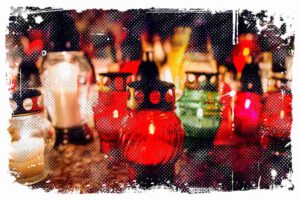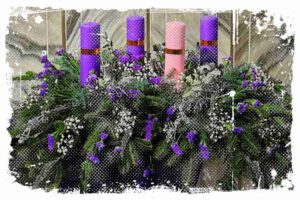Easter in Poland is a time rich with folk traditions and customs. While some of these customs are alive and well, others have slowly been fading away. Nevertheless, in Poland, you’ll still find people blessing food, painting Easter eggs, taking palms to churches, and splashing water on Wet Monday (Lany Poniedziałek). Some Easter customs have even transformed over time, like the „burial of sour rye soup” and herring, hanging Judas, Siuda Baba, dyngus..

There are different Easter traditions depending on where you live in the country. In Poland, many regions continue to cherish their old customs, even if they’ve changed a bit. For example, if you visit villages near Krakow, you’ll encounter colorful „pucheroki” and „Siuda Baba”. Plus, you can’t miss Emmaus, a bustling fair filld with countless stalls. And if you find yourself in Wilamowice, watch out for „Śmierguśnicy”, who might drench you with water.
Please check this article too: From Cabbage Pickling to Folk Dancing: 6 Unique Polish Autumn Traditions
Easter in Poland is a Movable Feast
Easter is a movable feast that always lands on the first Sunday following the spring full moon. Within the Christian faith, it’s known as the feast of the Resurrection of the Lord.
↳ PRO TIP: Do you like traveling? Then before you buy any ticket or book an attraction, check if it's available in this worldwide Viator Database. You may save a lot of money and time. No need to thank me :)
Easter 2024 in Poland – When to Celebrate?
Curious about when Easter falls in 2024? Since the date of the first spring full moon varies each calendar year, so does the date of Easter. In 2024, Easter is celebrated on March 31st. Holy Saturday takes place on March 30, and Holy Monday on April 1st.
Easter’s date hinges on the first spring full moon, resulting in a possible four-week range. The earliest possible date for Easter in general is March 22, while the latest is April 25.
Several other holidays are also determined by Easter’s date:
- Ash Wednesday
- Lent
- Paschal Triduum
- Ascension
- Pentecost (Whitsunday)
- Corpus Christi
It is worth to mention that Easter is regarded as the most important holiday in the Christian tradition. In Poland we celebrate it to honor the Resurrection of Christ and embrace a time filled with joy.
Carnival in Poland – A Time for Fun and Masquerades
Carnival (Karnawał) is a season of fantastic winter festivities and well-known masquerades and parades. The celebration kicks off with Epiphany and concludes the day before Ash Wednesday, which is 46 days before Easter and marks the beginning of Lent. The most renowned carnival events take place in Rio de Janeiro, Santa Cruz de Tenerife, London, and New Orleans. It’s believed that the carnival was introduced to Poland from Italy, where it originated in the 10th century. However, these days, it’s not often considered an Easter tradition in Poland.
In Poland, the carnival is celebrated rather modestly, with some cities hosting small, official balls. The celebration was much grander in the past, like in the 17th century when sleigh rides and masquerades were organized. Those events focused on dancing and feasting to one’s heart’s content.
The final days of the carnival, from Fat Thursday to the Tuesday before Ash Wednesday, are known as Shrove Tuesday. During this time, the balls become exceptionally lively and food-filled, as it’s the last chance to enjoy oneself before the long period of fasting and quiet.
Traditional carnival balls are now more popular among children than adults, with schools and kindergartens often organizing them. To keep the kids entertained, teachers also arrange:
- Competitions (for the most beautiful/original disguise or the most creatively crafted mask)
- Sports games (slalom with a ball or an egg on a spoon, eating an apple on a string without using hands, playing „warm and cold”, searching for hidden objects, etc.)
- Dance games (dancing with a balloon between a couple)
Sometimes, parents even organize a small masquerade at their own home, inviting friends and their children. This way, they can create a big family ball that caters to both the young and old.
Spring Cleaning – Typical In Poland Before Easter
I need to say, spring cleaning might not be a Christian Easter tradition, but it’s definitely an essential part of Polish culture. Every year, as the snow melts and the first sunny days arrive, families embark on a big cleaning in their homes. This thorough cleaning is a symbolic way to welcome the Easter holiday and say goodbye to the cold winter days.
Egg Painting – When We Unleash Our Creativity
Right before Easter, it’s time for one of the most enjoyable customs: painting Easter eggs. Eggs have long been a symbol of new life, which connects directly to the resurrection of Jesus Christ. In the past, people believed that naturally colored eggs (like those dyed with onion skins) had magical powers and could cure illnesses.
Easter eggs have always been linked to Polish Easter traditions, but they go by different names in various regions of Poland. In the north, you’ll find „kraszanki„, eggs boiled in colorful dye with patterns scratched onto them. In the areas around Kraków and Łowicz, „nalepianki” are popular, which are egs decorated with paper cutouts depicting folk ornaments. In Mazovia, you might see „oklejanka„, eggshells adorned with colorful yarn that look like artificial eggs or toys at first glance.
An old Easter game called „valatka” („out of stock”) involved opponents rolling their Easter eggs on a table. The person whose egg broke first would lose. In another version, players tapped the tips of their eggs against each other until one cracked.
Holy Week and Palm Sunday – A Journey Towards Easter
Holy Week starts with Palm Sunday, symbolizing Jesus Christ’s entry into Jerusalem. You bring colorful Easter palms to church to be blessed. While people used to make these palms themselves, most now buy them, typically made from boxwood, willow twigs, dried flowers, and herbs. However, the tradition of crafting palms by hand hasn’t disappeared completely! In many towns, competitions are held for the most beautiful, tallest, or most original palm.

The blessed palm was considered a symbol of good luck, so it was hung in a prominent place at home for a year, until it was replaced by a new one. This tradition, although perhaps less focused on the magical aspects of good fortune, is still practiced by many families.
Holy Week ends with the Paschal Triduum. It begins on Maundy Thursday evening, covers Good Friday and Holy Saturday, and concludes on Holy Sunday evening, which is the first day of Easter. On Sunday (or in some areas, late Saturday evening), the Easter Vigil liturgy takes place. This is the most important mass of the year in the Catholic Church, as it celebrates the resurrection of Jesus Christ.

On Holy Saturday morning, people typically bring food to church to be blessed. The items brought are symbolic, usually fitting into a small basket.
These include:
- eggs (a symbol of new life)
- sausages (a symbol of fertility)
- horseradish (a symbol of abundance)
- salt (a symbol of purification from evil)
- and much more..
The basket is often decorated with a figurine of a lamb (made of sugar, butter, or bread, symbolizing Jesus Christ) and catkins. In the past, much more food was blessed, including everything the family planned to eat for Easter breakfast or even throughout the holidays.
Wet Monday – Fun and Laughter on Easter Monday
Wet Monday, also known as „Śmigus-Dyngus” or „Great Monday”, is the second day of Easter and eagerly anticipated, especially by the youngest members of the family. The custom of pouring water on people goes back to pagan times, although Śmigus and Dyngus used to be separate rites.

During „Śmigus”, boys would gently lash the calves of the girls they met with willow twigs or sprinkle them with water, which led to the current Easter tradition. Meanwhile, during Dyngus, people went from house to house, singing and wishing each other well while asking for sweets or money.
Nowadays, children often buy special sprays or plastic guns and have fun soaking each other. In some households, there’s even a tradition of waking up family members in the morning with cold water. Although not everyone looks forward to getting drenched, it’s worth mentioning that being wet during Śmigus-Dyngus is said to bring happiness.
The Dyngus Rooster – A Fading Tradition
A disappearing custom during Easter in Poland is the so-called dyngus rooster. Celebrated alongside Wet Monday, this tradition involves youths riding with a rooster (formerly alive, now replaced with an artificial one made of dough or clay) on a cart throughout the entire village. They sing, collect money and small gifts, and pour water on the girls they meet along the way.
You may also be interested in reading this article: Thanksgiving Traditions Around the World: Does Poland Celebrate?
Lesser-Known Easter Traditions in Polish Regions
Here are some traditions and customs that are no longer that popular. To be honest, I didn’t even know about most of them myself before writing this article.
Pucheroki – Orations for Gifts and Laughs
In areas surrounding Krakow, such as Bibice, Zielonki, Trojanowice, and Tomaszowice, Pucheroki is celebrated on Palm Sunday. Stemming from old games played by Krakow’s students, young boys give humorous orations and receive small payments or gifts in return. Their faces are stained with soot, and they wear sheepskin coats and high conical hats decorated with colorful tissue paper.
Hanging Judas – The Traitor’s Punishment

The Easter tradition of hanging or drowning Judas has its rooots in Christian tradition, symbolizing the punishment of the traitor who betrayed Jesus Christ. Similar to the spring drowning of Marzanna in Poland, the effigy of Judas, made of straw and dressed in torn clothes, is hung on a church tower or pole. It is then knocked down and beaten with sticks as a procession moves through the village. Finally, it is set on fire and thrown into the river. This custom has mostly survived in Podkarpacie region, such as in village of Pruchnik.
Burying Sour Rye Soup and Hanging Herring
Strict fasting traditions were followed before and during Easter holidays in the past. Foods like sour rye soup and herring were common during Lent. When fasting ended, a symbolic funeral for sour rye soup and herring was held, especially in Kujawy. On Good Friday evening or Holy Saturday morning, the pot containing sour rye soup was emptied into a dug pit and buried. A wooden or cardboard herring was hung on a tree, marking the end of the fasting period and the beginning of the festive Easter breakfast.
Easter Egg Hunt – Searching for Bunny’s Gifts

In western Poland, the custom of „looking for a bunny” is popular, involving small gifts or sweets hidden by a hare, much like an Easter egg hunt. This hare leaves gifts in Silesia, Western Pomerania, and Greater Poland on Holy Sunday morning (or Maundy Thursday in some regions). The bunny is the Easter equivalent of Santa Claus, bringing modest gifts that are hidden around the house or garden for children to find after breakfast. This tradition likely originated from Germany and Anglo-Saxon countries.
Przywołówki – Poems and Songs for Girls
On Easter Sunday evening, another tradition called przywołówki was celebrated in Kujawy. Boys from the village gathered in the central square, climbed a platform, and „called” local girls by reading poems or singing songs for them. Sometimes they also gave small gifts to win their affection.
Śmiergust – A Silesian Spin on Śmigus-Dyngus
Śmiergust is an Easter custom similar to Śmigus-Dyngus but celebrated differently, occurring only in Silesia, particularly in Wilamowice, on Holy Monday. Boys dress up in colorful costumes, don hats decorated with tissue paper, and often wear hand-made masks. They go from house to house, pouring water on girls they meet, then dance and sing with them. As with Śmigus-Dyngus, wet girls are believed to have a better chance of getting married soon.
Siuda Baba – A Lesser Poland Tradition
Siuda Baba is another Easter tradition from Lesser Poland, with roots in pagan customs related to driving away winter. Celebrated on Easter Monday, a young man disguises himself as a priestess, painting his whole body with soot and wearing beads made of chestnuts, potatoes, or wood. He goes from house to house with a retinue, collecting donations. Having one’s face blackened by Siuda Baba is considered to bring good luck, and for girls, it is believed to herald a quick marriage. This custom is mainly celebrated in Lednica Górna and Wieliczka, although in slightly different forms.
Emmaus – Indulgence and Celebration
On Easter Monday, Emmaus, or indulgence, is organized in Poland, the Czech Republic, and Slovakia. The most famous Emmaus in Poland takes place in Krakow. Games for children and other attractions, such as loteries for the whole family, are organized, along with numerous stalls selling toys and sweets.
While the indulgence currently serves mostly as entertainment, it once had a spiritual dimension, with villagers taking a solemn walk together after spending the day together. The name „Emaus” comes from the biblical village where Jesus Christ was heading, unrecognized even by his disciples. The fair was a celebration commemorating this event.
You may also find interesting this: A Look into the History and Tradition of Candlemas Day in Poland
Sleeve – Rolling Eggs and Honoring Tradition
After Easter, the sleeve custom is celebrated in Krakow on the Tuesday following Easter. This tradition dates back to at least the 18th century and has ties to the Slavic tradition of Dziady. Wealthier inhabitants of the city used to climb Krak Mound, which was built by the people themselves (hence the name „the sleeve”), and dropped food or small coins to the poor during the fair. Today, the sleeve is celebrated differently, with people visiting Krak Mound for the annual festival and eggs being rolled symbolically.
Easter traditions in Poland have evolved over centuries and are now celebrated for their moral and cultural significance. These customs were once believed to ensure happiness and prosperity in life. The diversity of traditions in different regions tells the story of how Easter was celebrated in the past and sheds light on the origins of some ceremonies in Poland, as many traditions were borrowed from neighboring countries. As you prepare for Easter, consider sharing these lesser-known traditions with your family to keep the rich and long-standing customs alive.
References:
- https://www.garneczki.pl/blog/tradycje-i-zwyczaje-wielkanocne-w-polsce/
- https://magazyn.travelist.pl/wielkanoc-w-polsce-najciekawsze-miejsca-i-tradycje/



